
Silene chalcedonica, the Maltese-cross or scarlet lychnis, is a species of flowering plant in the family Caryophyllaceae, native to Eurasia. Other common names include flower of Bristol, Jerusalem cross and nonesuch.

Claytonia virginica, the Virginia springbeauty, eastern spring beauty, grass-flower or fairy spud, is an herbaceous perennial plant in the family Montiaceae. Its native range is eastern North America. Its scientific name honors Colonial Virginian botanist John Clayton (1694–1773).

Cornus racemosa, the northern swamp dogwood, gray dogwood, or panicle dogwood, is a shrubby plant native to southeastern Canada and the northeastern United States. It is a member of the dogwood genus Cornus and the family Cornaceae.

Ditrysinia is a plant genus of the family Euphorbiaceae first described as a genus in 1825. It contains only one recognized species, Ditrysinia fruticosa, the Gulf Sebastian-bush, native to the southeastern United States.

Staphylea trifolia, the American bladdernut, is native to eastern North America, from southern Ontario and southwestern Quebec west to Nebraska and Arkansas, and south to Florida. It is sometimes used as an ornamental plant.
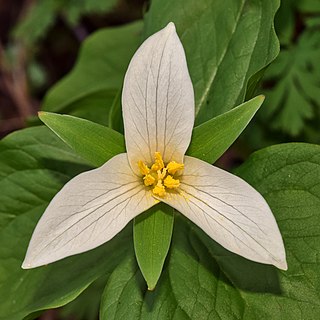
Trillium ovatum, the Pacific trillium, also known as the western wakerobin, western white trillium, or western trillium, is a species of flowering plant in the family Melanthiaceae. It is found in western North America, from southern British Columbia and the tip of southwestern Alberta to central California, east to Idaho and western Montana. There is an isolated population in northern Colorado and southern Wyoming.

Liatris pycnostachya, the prairie blazing star, cattail gayfeather or cattail blazing star, is a perennial plant in the Asteraceae family that is native to the tallgrass prairies of the central United States.

Allium acuminatum, also known as the tapertip onion or Hooker's onion, is a species in the genus Allium native to North America.

Corylus americana, the American hazelnut or American hazel, is a species of deciduous shrub in the genus Corylus, native to the eastern and central United States and extreme southern parts of eastern and central Canada.

Helianthus grosseserratus, commonly known as sawtooth sunflower or thick-tooth sunflower, is a perennial sunflower in the family Asteraceae, with a large flowering head (inflorescence).
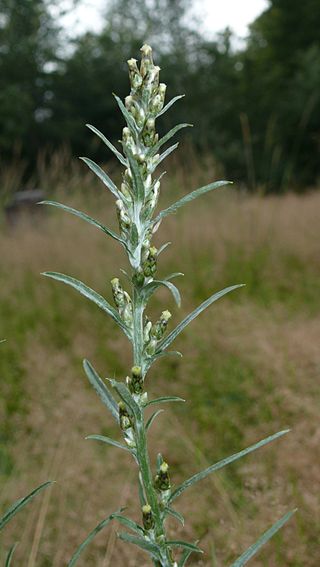
Omalotheca sylvatica, synonyms including Gnaphalium sylvaticum, is a species of plant in the family Asteraceae. It is commonly known as heath cudweed, wood cudweed, golden motherwort, chafeweed, owl's crown, and woodland arctic cudweed. It is widespread across the temperate Northern Hemisphere, throughout North America and Eurasia. The species was first formally described by Carl Linnaeus in 1753 as Gnaphalium sylvaticum.
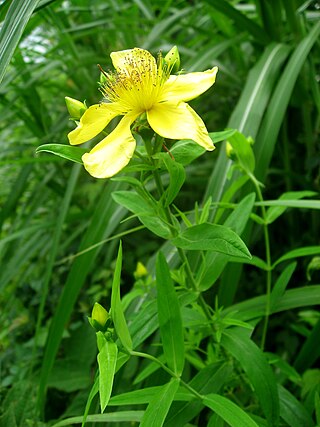
Hypericum ascyron, the great St. Johnswort or giant St. John's wort is a flowering plant in the family Hypericaceae.
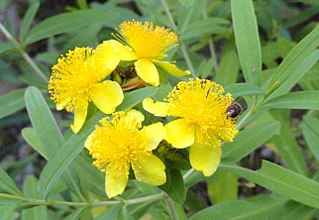
Hypericum kalmianum, commonly called Kalm's St. Johns wort or Kalm's St. Johnswort, is a flowering plant in the St. John's wort family Hypericaceae. It is native to the Great Lakes region in the northern United States and southern Canada. Hypericum kalmianum was named after its discoverer, Swedish botanist Pehr Kalm (1715-1779).

Hypericum tenuifolium, known as Atlantic St. John's-wort and sandhill St. John's-wort, is a species of flowering plant in the St. John's wort family, Hypericaceae. It is native to the Southeastern United States.

Hypericum suffruticosum, known as pineland St. John's-wort, is a species of flowering plant in the St. John's wort family, Hypericaceae. It is native to the Southeastern United States.
Hypericum galioides, the bedstraw St. Johnswort, is a species of flowering plant in the St. John's wort family, Hypericaceae. It is endemic to the Southeastern United States.

Hypericum tetrapetalum, the fourpetal St. Johnswort, is a species of flowering plant in the St. John's wort family, Hypericaceae. It is found in the Southeastern United States and Cuba. It was first described by Jean-Baptiste Lamarck in 1797.
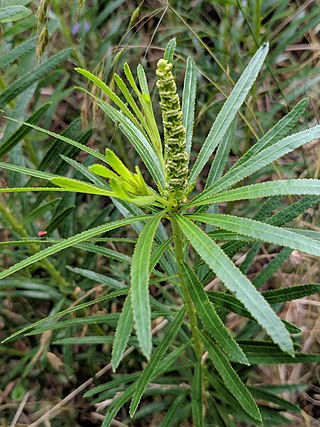
Stillingia texana, the Texas toothleaf, is a species of flowering plant in the family Euphorbiaceae. It is native to the South Central United States and Mexico. In central Texas it is widespread in upland, calcareous prairies, spreading north to scattered locations in Oklahoma and south to Coahuila. Stillingia texana was described in 1923 by Ivan Murray Johnston.

Stillingia treculiana, Trecul's toothleaf, is a species of flowering plant in the family Euphorbiaceae. It was originally described as Gymnanthes treculianaMüll.Arg. in 1865. It is native to southern Texas in the United States and northeast Mexico, growing in sandy and gravelly soils in dry habitats.
Stillingia paucidentata, the Mojave toothleaf, is a species of flowering plant in the spurge family, Euphorbiaceae. The Mojave toothleaf is endemic to southeastern California in the United States. It may occur in nearby western Arizona, but no specimens from that state have been conclusively confirmed. It grows in sandy areas and dry slopes, flowering between March and May and fruiting in May and June.



















